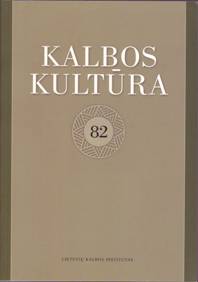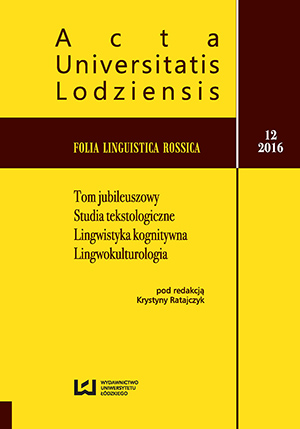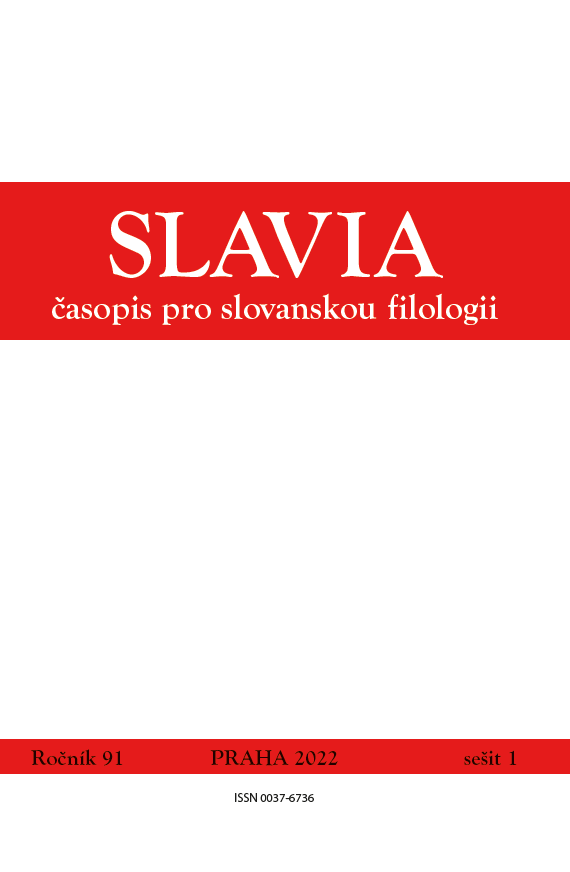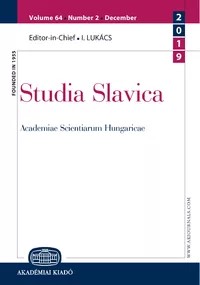Е. Н. Мустаев, сопоставительное языкознание. русский и марийский языки. учебное пособие, Йошкар-Ола 2013
Review on: J. N. Mustajev, Sopostavitel'noje jazykoznanije. Russkij i marijskij jazyki. Utshebnoje posobije, Joshkar-Ola 2013
More...We kindly inform you that, as long as the subject affiliation of our 300.000+ articles is in progress, you might get unsufficient or no results on your third level or second level search. In this case, please broaden your search criteria.
Review on: J. N. Mustajev, Sopostavitel'noje jazykoznanije. Russkij i marijskij jazyki. Utshebnoje posobije, Joshkar-Ola 2013
More...
The article deals with the problem of the so-called “eastslavonic influence” on southslavonic literature in 12th–13th centuries. The idea, based on claims that some Bulgarian and Serbian manuscripts of the period (among them Berlinski Sbornik) contain russicisms, is complete misconception.
More...
The article presents the results of the analysis of the system-structural organization of the precedent name Ivan included into the cognitive base of Russian lingvo-cultural community (according to the data of the chain associative experiment). The precedence of anthroponym is caused by its multidimensional connections with phenomena of Russian culture, first of all with works of folklore.
More...
This article deals with certain aspects of prosody involving the differences between the written and spoken text of the movie Kislorod. For this article, the most significant deviations from the Russian intonation constructions have been elaborated upon in order to interpret their meaning and show their possible impact on the Czech version of the movie lyrics.
More...
This article has two aims: 1. to thank the reviewers of the two-volume publication Brasławszczyzna, memory and the present for their careful study of the texts and glossaries included in it, for eliciting and emphasizing methodological, theoretical and material merits, and revealing some of its shortcomings. 2. To open the opportunity for me, as the author and the editor of the project, to engage in polemics with some of the outlooks of the reviewers and to show, from time perspective, what could have been done better.
More...
The article outlines the typical symptoms of quantitative and qualitative asymmetry of the form and content at the level of complex conjunctive structures of the modern Ukrainian language. The analyzed material proves the prevalence of formal semantic inconsistencies in the syntax of a complex conjunctive sentence and proves the need for holistic and comprehensive studies of this phenomenon on the syntactic level of the Ukrainian language system as a whole.
More...
The adverbs of the adjective origin are being analyzed in this Paper. The starting point are different theories that explain the origin of that type of adjectives. The analysis itself divides the adjectival adverbs into two groups. The first group is made up of those made through adverbialization by transition of adjectives into adverbs, i.e. by “freezing” of a certain case form of the adjective. In that process, not only a certain morphological form is being petrified, but the semantics of the words is being changed too. Such adverbialized adverbs are being divided into two parts: the ones made by a simple and complex adverbialization. The second group is made up of adverbs made morphologically i.e. most often when the adverbialized forms have already become a usual model according to which adverbs are being formed (so that the former adjectival suffix became a formation suffix), or by adding of other affixes.
More...
The paper discusses definitions of the concept native language and different national concepts of the notion concerned with one’s mother tongue as well as its ambiguity arising in different research areas. The paper also includes some responses and reflections on a native language provided by Russian language speakers of Lithuania; the data has been extracted from the survey recently conducted in Lithuania. These reflections could be treated as naïve definitions of the above notion. Further in the paper, the key factors determining the respondents’ definitions of the native language are given. The spreading binary character of the categoryis also taken into consideration: more frequently, alongside one native language (of an early, pre-school period of life), there emerges another language (other than the one spoken at home, language of instruction), which is closely related to human cognition. The latter language becomes an individual’s second native language. The results of the survey have shown that the opposition between ‘own’ and ‘other’ language often characteristic of a homogenous monolingual society in the understanding of Russian speakers of Lithuania is replaced by two equally important ‘own’ halves.
More...
Several analyses have summarized the linguistic situation of Ukraine, highlighting various aspects of the problematic issues of Ukraine’s language policy. The fundamental problems of the linguistic situation in Ukraine are the lack of consensus regarding the issue of what role the Ukrainian language has in constructing the new post-Soviet identity and in nation building, what status the Russian language should be given in Ukraine. According to the data from the 2001 census, 80% of the adult population of Ukraine speak (at least) one other language fluently in addition to their mother tongue. In the country it is clear that the reality in most of Ukraine is of bilingualism. Almost everyone in Ukraine is bilingual; to varying degrees, a fundamental characteristic of the language situation in Ukraine is bilingualism of society. In spite of this, due to negative historical experiences, bilingualism is stigmatized in Ukraine, and that makes codification of bilingualism impossible on the state level. The paper shows the attitude of the political elite that took power after the overthrow of President Viktor Yanukovych towards the issue of bilingualism. We present how the linguists and representatives of the intellectuals comment on the bilingualism in Ukraine. The primordial, national romantic view that makes the Ukrainian language and the (free and independent) Ukrainian nation the same nowadays strongly dominates in Ukraine.
More...
The author emphasizes the characteristic for traditional Slavic culture relations of concept “Osud” ‘fate’ with good and bad times. It is significant that many words with temporal meaning value throughout its history could have the semantics of fate in Slavonc languages. In Kundera’s novel concept “Osud” accompanied by the word skvrna ‘spot, evil’, which is associated with the concept of ritual impurity caused by food-fasting.In the Mirek’s mind, the protagonist of the first part of the novel, his life is separated from the fate. It seeks to erase from his life everything, what is unworthy of its destiny. As a result, he rewrites history, like the totalitarian regime against which he fights.
More...
Slang is defined here as a language variety used predominantly in spoken discourse by a social group sharing interests, whose members are unified by position within society and possibly age.The paper analyses word formation rules of contemporary Russian student slang. The corpus is made up of youth slang dictionary entries, including student slang, internet fora for students as well as questionnaires sent out to students.Productive word formation rules in Russian student slang include: morphological (e.g. abbreviation root word shortening), metaphorisation and loan words; phonetic mimicry also plays a significant role. Students tend to engage in wordplay and create puns freely. Their language is witty and expressive.
More...
This article argues that a double-verb construction built around the verb wziąć and the element i – the so-called J(uncture)-WZIĄĆ gram – is a less canonical Serial Verb Construction (SVC). The gram complies with all the traits postulated as inherent to the prototype of SVCs with one noticeable exception – it exhibits an element that is homophonous with the conjunctive coordinator i ‘and’. However, i in the J-WZIĄĆ gram is not a true coordinator, nor is the J-WZIĄĆ gram a genuine coordinated structure. Rather, i functions as a dummy juncture, and the J-WZIĄĆ gram constitutes an example of pseudo-coordination – a stage on the grammaticalization path from coordination to verbal serialization.
More...
Analyzing a corpus of over 36,000 words of foreign origin and 33,000 native words, the paper presents a detailed account and comparison of the distribution of consonant-vowel combinations in Czech. These combinations are discussed according to their vowel class. Both combinations typical for foreign-origin words and combinations typical for native words were found. In some cases, the typicality is predictable from the phonemes in the combinations (i.e. from the phonemes typical for either type of vocabulary), but there are many combination types for which this is not possible. The paper concludes with a discussion of the factors that may influence the distribution of consonant-vowel combinations, including sound changes, phoneme frequency, morphological processes, and universal preferences in the combinability of consonants with vowels. Special attention is paid to loanwords from English.
More...
This paper explores the pronunciation of the dental fricatives /θ ð/ in loanwords of English origin (i.e. Anglicisms) as well as in English proper names in Czech. I identify a considerable gap between the recommended and actual pronunciation of the dental fricatives: while alveolar fricatives (/s z/) are recommended in language manuals and textbooks, in actual language use Czech speakers pronounce the dental fricatives predominantly as alveolar stops (/t d/). My hypothesis for this imbalance between recommended and actual pronunciation is that, to date, authors of language manuals and textbooks have failed to take into account both the pronunciation norm of Czech speakers and the original English pronunciation. I make a number of arguments for the replacement of the English phonemes /θ ð/ with the Czech phonemes /t d/ or /f v/, which I consider more suitable than their replacement with the “recommended” /s z/. However, given the lack of reliable guidelines for the pronunciation of the dental fricatives, I observe both significant variability in pronunciation, particularly in the case of recent loanwords such as smoothie and think tank, and a high level of uncertainty among speakers with respect to how Anglicisms containing dental fricatives should be pronounced.
More...
Against the background of crosslinguistic research on the grammaticalization of type nouns in Germanic and Romance languages, this article examines nominal constructions with the Russian rod (‘genus’, ‘genre’, ‘kind’) and tip (‘type’). The study proposes a comprehensive typology of constructions based on their functional-structural properties and semantic characteristics. Generalization of meaning, decrease in semantic substance and compositionality, pragmaticalization and lexicalization concern mainly constructions with rod. Rod is argued to be overall more advanced on the path of desemanticization, conceivably because tip is a relatively recent borrowing and features a more specific meaning. While tip retains its taxonomic meaning in most contexts, constructions with rod are shown to fulfil more diverse functions and to be used predominantly for the purposes of hedging, textual cohesion (anaphoric reference) and indication of variety and quantification.
More...
The article focuses on phrase description in the works of art by Dmytro Keshelia, denoting the life, manners and customs of the Transcarpathians, their positions in society and also interpersonal relations, deeds, behaviour, quality, the state of an object, phenomenon. It has been found that his skill turns out to be both in the choice of phrases, renewal and extension of phraseological contexts and connections, in a neat feeling of a semantic and stylistic peculiarities of general language phrases and in creating new author units, being the basic feature of his idiolect and replenish the phraseological stock of the dialect as well as the Ukrainian literary language. As a result of the study the author affirms, that D. Keshelia neatly transformed set phrases in his works of art, fundamentally interspersing special features of his native patois in them. She comes to the conclusion that there are a lot of picturesque phrases, reflecting contacts among people, the attitude to one another and the description of one character by another.
More...
The article pays attention to the proverbs and sayings of the Ruthenians-Ukrainians of Slovakia. The author gives an overview of publications focused on the research on these paremiological units in the second half of the 20th century up to the present day and among well-known collectors of oral folklore introduces e.g. J. Cihra and I. Legdan, M. Mušinka, N. Varcholová, M. Hirjak and Z. Hanudeľ, J. Varchol, M. Šmajda and others. She also pays attention to the thematic focus of the registered language units, in which human being and his/her character, love for his/her homeland, family relationships, joy, success as well as sadness and human suffering predominate. The rich dialect material of the researched region was also published in the national minority media.
More...
In the Old Russian writings of the 11th–12th centuries there are found spelling systems in which the letters ъ and ь are frequently confused with one another. The use of jers in such systems reflects the facts of different periods in the development of Slavonic writing. This article considers the East Slavonic copy of the Homilies by Cyril of Jerusalem, which provides indicative material for describing the heterogeneous nature of the jers’ confusion. This orthographic feature is presented in the manuscript by thousands of examples in a large number of morphemes. The analysis of complete sampling of material on variation of the letters ъ and ь and comparison of the spelling of the Old Russian manuscript with the testimony of Old Slavonic manuscripts allows us to show that some of jers in non-etymological positions owe their appearance to the East Slavonic scribe. The highest frequency of confusion is reached in spelling groups with orthographically marked positions that were subject to recoding in the process of developing the original Old Russian spelling norm. The considered data suggest that the perception of South Slavonic spelling with a confusion of jers in Rus’ was not limited to simple copying, but could provoke the appearance of original spelling techniques.
More...
In the paper, the author carried out an analysis of compound words in the Ukrainian language of the beginning of the 20th century. The research is based on three popular Russian–Ukrainian bilingual dictionaries published in the period from 1918 to 1933: Moscow–Ukrainian Dictionary (1918) by Victor Dubrovskyi, Russian–Ukrainian Dictionary (1918) by Sergiy Ivanytskyi and Fedir Shumlyanskyi, and the academic Rus- sian–Ukrainian Dictionary (1924–1933) edited by Agathangel Krymskyi and Sergiy Yefremov. A comprehensive study became possible due to uniquely built digital lexicographic systems and a noun database. They were created on the basis of the paper dictionaries listed above (digitized copies). All compound words were selected from the noun database, methods of their creation were studied, the main thematic groups were highlighted and described.
More...
Benedek Gergely:Komlóska ruszin nyelvjárása [Русинська говірка села Комлошка]. (A Magyar Nyelvtudományi Társaság Kiadványai 241.) Budapest: Magyar Nyelvtudományi Társaság, 2022. 171 p.
More...